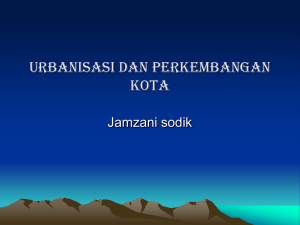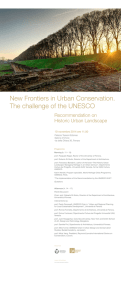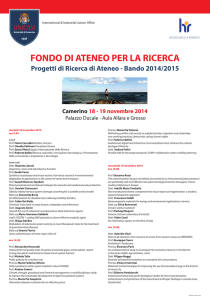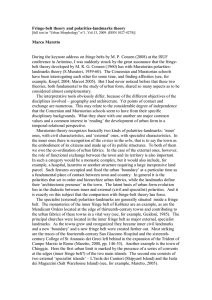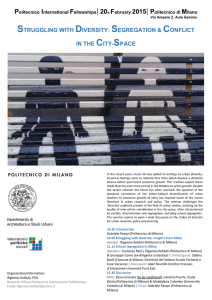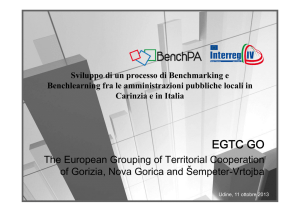STUDI PERKOTAAN (gPW
advertisement
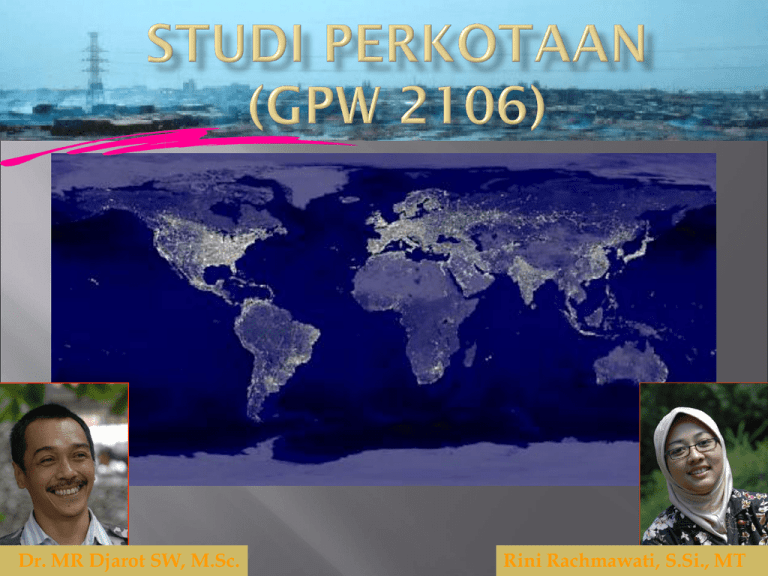
Dr. MR Djarot SW, M.Sc. Rini Rachmawati, S.Si., MT What are Urban Studies? All scientific issues addressing the urban space and society can be summarized as Urban Studies; It is a broad and vague term but a very relevant and multidisciplinary (sub)discipline of Geography, Sociology, Anthropology, Architecture; Urban Studies include research on the physical structure of a city, the population, the urban culture and society, the economic development and the governance structure (including urban planning). THE BIG PICTURES (1800) First Billion 130 (1930) Second Third Fourth 30 (1960) 15 (1975) Fifth 12 (1987) Sixth 12 (1999) Seventh 14 (2013) Eighth 14 (2027) Ninth 21 (2048) THE BIG PICTURES 10 9 8 7 6 5 4 Less Developed Regions 3 2 1 0 1950 More Developed Regions 1970 1990 2010 2030 Source: United Nations, World Population Prospects: The 2004 Revision (medium scenario), 2005. 2050 THE BIG PICTURES THE BIG PICTURES THE BIG PICTURES World Population Clock 2005 Natural Increase per More Developed Countries World Less Developed Countries Less Developed Countries (less China) Year 80,794,218 1,234,907 79,559,311 71,906,587 Day 221,354 3,383 217,971 197,004 154 2 151 137 Minute Source: Population Reference Bureau, 2005 World Population Data Sheet. THE BIG PICTURES THE BIG PICTURES POKOK BAHASAN • Konteks Global Urbanisasi • Konsep, batasan, dan tipe daerah perkotaan • Sistem Perkotaan • intra-urban study • Kebijakan dan perencanaan daerah perkotaan • The Future of the City – Cities of the Future GEOGRAFI DAN STUDI PERKOTAAN Kegiatan manusia (ekonomi, politik, sosial, budaya, dll.) ORGANISASI KERUANGAN GEOGRAFI The study of the earth’s surface as the space within which the human population lives (Johnston, 1981) ANALISA KERUANGAN Lingkungan alam ANALISA KOMPLEKS WILAYAH (tanah, batuan, air, udara, flora, fauna, dll. (intra-regional) HUBUNGAN MANUSIALINGKUNGAN ANALISA EKOLOGI (ekosistem) TEKNIK atau ALAT DASAR (Basic tools: kartografi, PJ, SIG, Statistik, dll.) S T U D I P E R K O T A A N Konteks Global Urbanisasi Mempelajari urbanisasi sebagai suatu proses erat terkait dengan pendekatan sistem Pendekatan sistem adalah proses penerapan metode ilmiah dalam pemecahan masalah berdasarkan pemikiran sistemik, yang memandang segala sesuatu bersegi banyak (multi dimensi), penuh kompleksitas dan selalu merupakan bagian dari sistem yang lebih luas atau lebih besar. Sistem adalah suatu totalitas yang kompleks, terdiri dari seperangkat bagian-bagian yang saling berinteraksi dalam suatu bentuk saling ketergantungan yang teratur, untuk mencapai tujuan tertentu Sebuah sistem mempunyai ciri-ciri sebagai berikut: Pada hakekatnya sistem itu bersifat terbuka, selalu berinteraksi dengan lingkungannya. Setiap sistem terdiri dari dua atau lebih subsistem, dan setiap subsistem terbentuk dari beberapa subsistem yang lebih kecil. Antar subsistem terjalin saling ketergantungan, dalam arti bahwa subsistem yang satu membutuhkan masukan (input) dari subsistem lain dan keluaran (output) dari subsistem tersebut diperlukan sebagai masukan bagi subsistem yang lain lagi. Setiap sistem memiliki kemampuan menyesuaikan diri dengan lingkungan sekitarnya, melalui mekanisme umpan-balik (feed-back). Setiap sistem mempunyai keandalan dalam mengatur diri sendiri (self regulation). Setiap sistem mempunyai tujuan atau sasaran tertentu yang ingin dicapai. Konteks Global Urbanisasi Pola dan proses perkotaan global: URBANISASI Meningkatnya proporsi penduduk perkotaan pada suatu wilayah atau negara PERTUMBUHAN DAERAH PERKOTAAN Meningkatnya jumlah permukiman perkotaan di suatu wilayah atau negara URBANISME Penyebaran dan perubahan dinamika gaya hidup (way of life) perkotaan KonteksGlobal Global Urbanisasi Konteks Urbanisasi GLOBAL TRIGGERS OF URBANIZATION: ECONOMY POLITIC TECHNOLOGY SOCIETY DEMOGRAPHY CULTURE ENVIRONMENT Konteks Global Urbanisasi Perubahan/ dinamika Teknologi respon kebijakan dan perencanaan persoalan masyarakat Demografi Politik Sistem perkotaan Budaya Ekonomi URBANISASI Bentuk perkotaan Sosial Ekologi perkotaan Lingkungan Urbanisme Faktor lokal dan Historis Urbanisasi Sebagai Suatu Proses Konteks Global Urbanisasi DINAMIKA EKONOMI Perubahan dan dinamika ekonomi akan menentukan produk-produk APA, BAGAIMANA, dan DIMANA diproduksi dan dijual. Produksi (barang dan jasa) erat terkait dengan penguasaan dan perkembangan historis SISTEM TEKNOLOGI Ekonomi sistem teknologi •Kondratiev long waves (50-55 tahun) •Kuznets cycles (15-25 tahun) Konteks Global Urbanisasi DINAMIKA EKONOMI Siklus dan dinamika ekonomi sangat terkait dengan perkembangan cara produksi (mode of production) kapitalis: •Competitive (merchantalism) •Organized (fordist) •Disorganized (flexible) Konteks Global Urbanisasi Konteks Global Urbanisasi DINAMIKA DEMOGRAFI JUMLAH KEPADATAN KOMPOSISI DISTRIBUSI Konteks Global Urbanisasi DINAMIKA POLITIK PEMBANGUNAN RIVALITAS KELOMPOK REFORMASI POLITIK Konteks Global Urbanisasi DINAMIKA BUDAYA Kota sebagai pusat (pengembangan) budaya Post modern Konteks Global Urbanisasi DINAMIKA TEKNOLOGI Kota sebagai pusat PUSAT INOVASI IMPLIKASI TEKNOLOGI BARU Konteks Global Urbanisasi DINAMIKA SOSIAL Kota sebagai BAROMETER PERUBAHAN SOSIAL Konteks Global Urbanisasi The potential conflict between economic growth and environmental sustainability Urban economic development is often threatened by changes in national and global economies Urbanization is associated with social and political changes, which can undermine traditional social network and result in increase inequality and exclusion The government capabilities of the agencies responsible for achieving sustainable urbanization are inadequate Infrastructure is often deficient Economic, environmental and governance tensions make it difficult to realize the benefits of interdependence between urban and rural areas Konteks Global Urbanisasi Konsep dan Batasan Konteks Global Urbanisasi What is URBAN ? •Benarkah YOGYAKARTA adalah KOTA..? •Lalu, apa yang membedakan KOTA dan Desa..? •Apa bedanya antara: -Klaten -Yogyakarta -Jakarta -Singapura -Tokyo Konsep dan Batasan URBAN as entity •Population size •Population density •Built environment •Economic functions •Administrative function Konsep dan Batasan URBAN as a quality Meaning of urban places and effect on people’s lifestyle. •Subjective experience affects physical place •Urban way of life: urbanism •Now: more complex notions of urbanism Konsep dan Batasan URBAN VS RURAL Daerah Perdesaan Basis ekonomi utama adalah pertanian Komunitasnya relatif homogen dan kecil Tingkatan kelembagaan politik dan administratif adalah rendah Fasilitas pelayanan publik yang ada umumnya sedikit dan mempunyai tingkatan yang rendah Kepadatan daerah terbangun rendah dan mempunyai diferensiasi fungsi yang rendah pula Tingkat diferensiasi sosial dan spesialisasi okupasional relatif rendah Daerah Perkotaan Basis ekonomi utama adalah industri dan jasa Komunitasnya relatif heterogen dan besar Tingkatan kelembagaan politik dan administratif adalah tinggi Tingkatan fasilitas pelayanan publik lebih tinggi dan jumlahnya lebih banyak Kepadatan daerah terbangun yang tinggi dan terdapat spesialisasi fungsi yang tinggi Tingkat diferensiasi sosial dan spesialisasi okupasional relatif lebih tinggi Konsep dan Batasan URBAN di Indonesia Penetapan sebagai permukiman perkotaan dapat melalui tiga cara: pertama secara legal-administratif (misalnya, semua lokalitas yang berada di wilayah Kota Yogyakarta adalah permukiman perkotaan); kedua, adalah lokalitas yang penduduknya > 50.000 jiwa, atau bila persyaratan ini tidak terpenuhi; maka ketiga adalah lokalitas yang telah memenuhi persyaratan yang disandarkan atas tiga variabel, seperti kepadatan penduduk, persentase penduduk non-tani, dan ketersediaan fasilitas perkotaan: nilai harkat kumulatif dari ketiga variabel tersebut di atas, > 23 dikategorikan sebagai desa ‘urban’, < 17 dikategorikan sebagai desa ‘rural’, sedangkan permukiman yang memiliki nilai harkat diantaranya statusnya dianggap meragukan (Firman, 1992). Konsep dan Batasan URBAN di Indonesia LEGAL-ADMINISTRATIF 1980 2000 BERDASARKAN KRITERIA 1990 2000 Konsep dan Batasan Settlement types •hamlet •village •town •city •Metropolis •Megalopolis How about..: world city, mega-urban, urban agglomeration..? Konsep dan Batasan Inter URBAN URBAN ORIGIN AND GROWTH • pre industrial cities • medieval urbanization • industrial urbanization InterURBAN URBAN Inter URBAN ORIGIN AND GROWTH pre industrial cities Urban transformation process: • agricultural revolution • division of labor • large-scale social organization • trading network, specialization • warfare • religion Inter URBAN URBAN ORIGIN AND GROWTH pre industrial cities • Mesopotamia (+ 3500 SM) – Irak • Mesir …. (+ 3500 SM) • Lembah Indus (+ 2500 SM) – India • Sungai Kuning (+ 1800 SM) – Cina • Mediterania (+ 800 SM) – Yunani, Italia Sel. • Meso amerika (+ 200 SM)–Mexico, Guatemala Inter URBAN Inter URBAN URBAN ORIGIN AND GROWTH medieval urbanization • commercial revival • trade/merchant central • military fortification Inter URBAN URBAN ORIGIN AND GROWTH industrial urbanization • industrial revolution • factory system: economic of scale, productivity, high output • need for large labor pool, ancillary services, market • urban form shaped by factory system and class structure • segregated housing highly distinctive Inter URBAN URBAN ORIGIN AND GROWTH INDONESIA • Masa pra-kolonial (Abad ke-4 s/d ke-16) •kota dagang (market cities) •Kota pedalaman (inland cities, sacred cities) • intersuler, otonom • Masa kolonial (Abad ke-16 s/d abad ke-20) • sistem kota kolonial • primate city, entreport • Masa pasca-kolonial • incipient urbanization • mega-urban • mega urbanization, rural urbanization Inter URBAN National Urban System Sistem perkotaan: susunan lengkap saling-ketergantungan kota-kota di suatu wilayah atau negara Theoretical background Central Place Theory Diffusion Theories Inter URBAN Central Place Theory Inter URBAN Central Place Theory Inter URBAN Central Place Theory Inter URBAN Central Place Theory Inter URBAN Central Place Theory Jenis Fasilitas Pelayanan Juml. Pendidikan 01. Sekolah Dasar (SD) 02. Sek. Lanj. Tkt. Pertama (SLTP) 03. Sek. Lanj. Tkt. Atas (SLTA) 04. Perguruan Tinggi Jenis Fasiltas Pelayanan Juml. Pemasaran dan Produksi 2.518 568 376 91 32. Kelompok pertokoan 33. Pasar dgn. bang. permanen 34. Pasar tnp. bang. permanen 35. Pasar hewan 36. Pasar ikan 306 250 68 35 1 05. Rumah Sakit (RS) 27 37. Supermarket 41 06. Balai Kes. Ibu dan Anak (BKIA) 07. Rumah Sakit Bersalin 08. Poliklinik 09. Puskesmas 10. Puskesmas Pembantu 11. Balai Pengobatan 12. Tempat Praktek Dokter 13. Polindes 14. Apotik 15. Toko Obat 27 136 37 122 307 19 647 27 111 58 38. Toko elektronik 39. Kios KUD 40. Kios non KUD 41. Kawasan Industri 42. Sentra Industri 43. Lingkungan Industri Kcl 44. Perkampungan Industri 45. Pemasaran bahan galian 46. SPBU 47. Agen/penjaul LPG 48. Rumah makan/restoran 325 126 790 35 171 28 11 290 30 94 1.660 16. Bank Umum: kantor bank 17. Bank Umum: kantor kas 93 15 49. Wartel 180 18. Unit BRI 19. BPR non kred desa: pst dan cbg 20. BPR non kred desa: kantor kas 21. BPR bdn kred desa: bank desa 22. BPR bdn kred desa: lumbung ds 23. LKDP 24. Rumah Gadai 25. Kantor Asuransi 26. KUD 27. Kopinkra 28.Koperasi Simpan-pinjam 29. Non KUD lainnya 30. Lembaga Perkreditan lain 31. Lembaga Keuangan lain 120 64 8 120 75 44 19 35 60 15 641 350 42 76 50. Sewa alat-alat pesta 51. Sewa kaset /video/VCD 52. Sewa mobil/kend bermtr 53. Foto kopi 54. Reparasi kend tak bermtr 55. Reparasi kend bermotor 56. Reparasi elektronik 57. Salon kecantikan 58. Foto studio 59. Binatu 60. Hotel 61. Biro perjalanan wisata 62. Jasa Komputer Kesehatan Lembaga Keuangan Usaha dan Jasa Sewa 1.199 31 222 569 1.095 1.224 694 1.100 310 175 593 172 160 Inter URBAN Central Place Theory: Deficiencies Inter URBAN Diffusion Theories Inter URBAN Diffusion Theories 1. Exploration 2. Harvesting of natural resources 3. Emergence of farm-based staple production 4. Establishment of interior depot centers 5. Economic maturity and central place infilling Inter URBAN Diffusion Theories Inter URBAN Diffusion Theories Circular or cumulative upward causation Location of new industry Expansion of local employment and population Development of external economies former’s production Increase in local pool of trained industrial labor Development of ancillary industry to supply former with inputs, etc. Attraction of capital and enterprise to exploit expanding demand for locally produced goods and services Provision of better infrastructure for population and industrial development: roads, factory sites, public utilities, health and education services, etc. Expansion of local government funds through increased local tax yield Expansion of service industries and others serving local market Expansion of general wealth of community Inter URBAN Diffusion Theories Backward and forward linkages SERVICE SUPPLIERS Ancillary services Consultants, lawyers, advertising firms, etc. flows of information MATERIAL SUPPLIERS Suppliers of iron ore, coking coal, limestone, tungsten, equipment, etc. Backward Linkages Material flows flows of information STEEL PRODUCTION PLANT Material flows Material flows flows of information flows of information SERVICE SUPPLIERS Forward Linkages Consultants, lawyers, advertising firms, etc. Ancillary services MARKET Wire manufacturers, auto body manufacturers, cutlery manufacturers, machining firms, grinders, welders, etc. Intra URBAN Kebijakan dan Perencanaan
